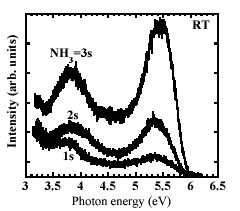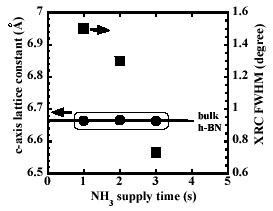Yasuyuki Kobayashi, Tetsuya Akasaka, and Toshiki
Makimoto
Materials Science Laboratory
Hexagonal boron nitride (h-BN) is a promising material system for exciton-based
quantum information processing and for optical device applications in the
ultraviolet spectral region. For investigating the optical properties and
fabricating optical devices with a p-n junction and quantum well structures,
a high-quality h-BN layer on a suitable substrate is indispensable. During
the past few decades, BN thin films have been deposited by a number of
methods. However, there has been no report of ultraviolet luminescence
at room temperature (RT) from these BN thin films.
Recently, we have achieved growth of single crystal h-BN (0001) heteroepitaxial
layers on Ni (111) substrate by flow-rate modulation epitaxy (FME) using
triethylboron and ammonia (NH3)
[1]. Here, we report RT observation of near-band-gap (NBG) luminescence at a
wavelength of 227 nm in cathodoluminescence (CL) from the h-BN heteroepitaxial
layers [2].
Figure 1 shows the CL spectra for h-BN layers grown under NH3 supply times
of 1, 2, and 3 s with NH3 flow rate of 700 sccm. A NBG ultraviolet
emission peak centered at energy of 5.47 eV (227 nm) and one broad deep-level
emission peak centered at around 3.85 eV (322 nm) are clearly observed for h-BN
layer grown under NH3 supply times of 3 s. To our knowledge, this
dominant NBG ultraviolet emission feature at RT has never reported for h-BN
films deposited on any substrates. The luminescence intensity at the NBG peak
increases monotonically with increasing NH3 supply time, indicating
that h-BN grown by FME with longer NH3 supply time is preferable for
obtaining stronger NBG luminescence.
Figure 2 shows the NH3 supply time dependence of c-axis lattice constant
and full width at half maximum (FWHM) of (0002) h-BN X-ray rocking curve (XRC)
for these three h-BN samples. The c-axis lattice constant of all three is
identical to that of bulk h-BN samples. The FWHM of the (0002) h-BN XRC decreases
from 1.5 to 0.7o with increasing NH3 supply time from 1
to 3 s. The FWHM of 0.7o is the narrowest value ever reported for a
h-BN layer. The lower h-BN growth rate and larger amount of NH3 with
the longer NH3 supply time may reduce the lattice defects in h-BN
heteroepitaxial layers, resulting in the stronger NBG ultraviolet emission from
h-BN samples.
The present result is a vital step toward the ultimate goal of h-BN-based
optical devices.
[1] Y. Kobayashi, et al., J. Cryst. Growth 298 (2007) 325.
[2] Y. Kobayashi, et al., Phys. Stat. Sol. (b) 244 (2007) 1789.
 |
 |
||||
|
|